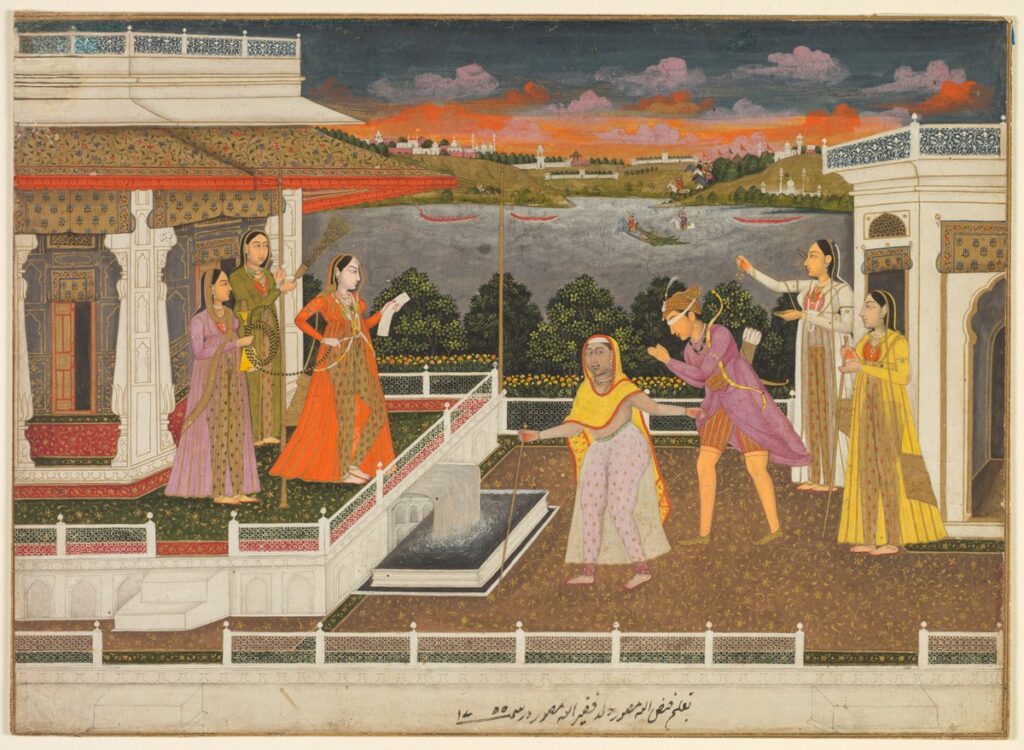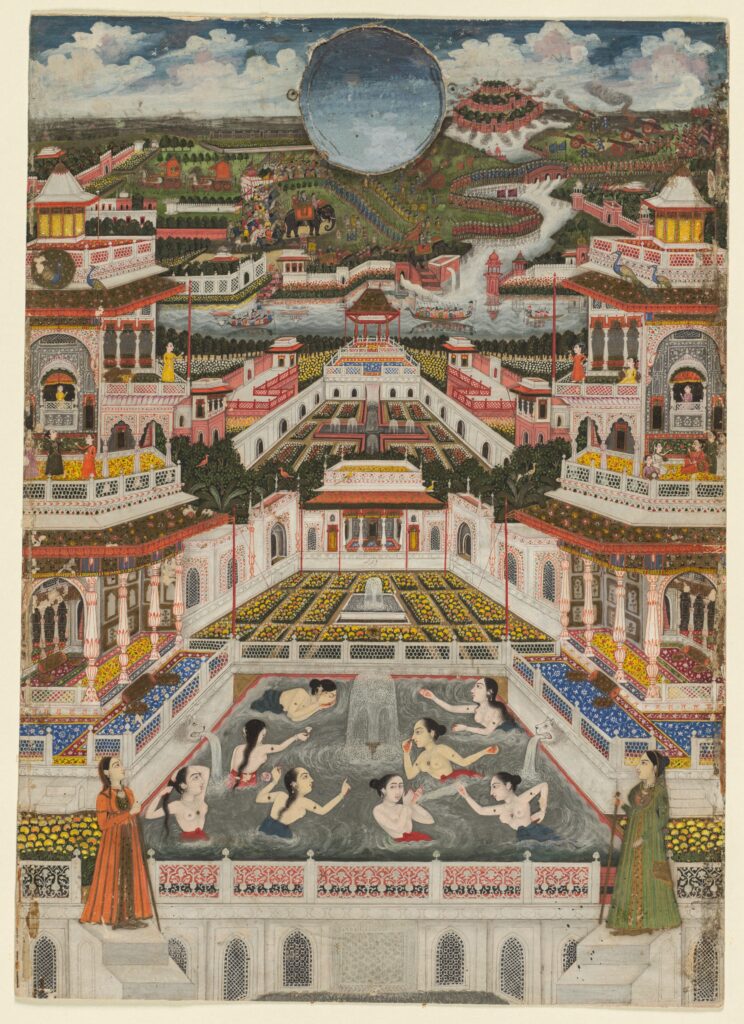Shiva Nataraja – The Hindu Lord of the Dance. Iconography and Symbolism
Nataraja, the manifestation of the Hindu god Shiva as the Lord of the Dance, holds a profound significance in Hindu mythology and symbolism. Depicted...
Maya M. Tola 3 June 2024
7 December 2023 min Read
Fayzullah was a renowned artist of the royal Mughal atelier in the late 18th century, during the reign of Alamgir II. Two of his masterpieces, Blindfolded Suitor is Brought Before a Princess and Women Bathing before an Architectural Panorama, both unique in subject matter and theme, demonstrate his artistic vision as well as provide a glimpse into unique cultural nuances of the Mughal reign that Fayzullah witnessed.

Fayzullah, A blindfolded suitor is brought before a princess, ca. 1755, Cleveland Museum of Art, Cleveland, OH, USA. Detail.
Alamgir II, originally named Aziz-ud-Din Muhammad, was the second son of Emperor Jahandar Shah. He assumed the throne on June 3, 1754, after deposing Ahmad Shah Bahadur, becoming the fifteenth emperor of the illustrious Mughal dynasty. His reign extended until November 29, 1759. Alamgir II’s rule occurred well after the golden age of the Mughal arts, and by his time, the royal atelier had evolved into a smoothly functioning and well-funded machine, supported generously by the royal coffers.

Fayzullah, A blindfolded suitor is brought before a princess, ca. 1755, Cleveland Museum of Art, Cleveland, OH, USA. Detail of the river.
Little is known about many artists of the royal atelier, and unfortunately, Fayzullah is no exception. It is speculated that he might have been the son of Faqirullah, a painter in the royal court who also trained him to be an artist—an occurrence not uncommon in the Mughal court of that era.
Nevertheless, it has been determined that Fayzullah was likely situated in the city of Lucknow (present-day Uttar Pradesh) which served as the administrative seat of the Mughal empire during that period. His active period is estimated to have spanned from 1730 to 1765.

Fayzullah, A blindfolded suitor is brought before a princess (recto), ca. 1755, Cleveland Museum of Art, Cleveland, OH, USA.
In this painting by Fayzullah, he has demonstrated his remarkable talent for intricate details and vivid depictions on a relatively small scale. Architectural features in fine Mughal style dominate the composition, from intricately patterned balcony railings to the shamiana below, adorned with floral patterns and bordered textiles. The meticulously planned Mughal landscape also hints at the possibility of a Hindu temple in the distant background, showcasing the empire’s cultural diversity and tolerance while underscoring the dominant role of the Islamic rulers of the period.
The painting weaves a complex narrative with various elements interwoven into the backdrop scene. Notably, a band of men on horseback leads a charge, and a dramatic crocodile attack. However, the focal point lies in the foreground, where seven figures take center stage.
Departing from traditional depictions, the women here hold dominant positions. The central figure, adorned in coral, is attended to by others as she reads a note, presumably pertaining to the suitor that has been brought before her.
The narrative, the act of reading and this portrayal of women in authoritative roles, imparts a contemporary and feminist sensibility to the scene, emphasizing the significant role played by women in the cultural and political landscape of the Mughal court during this period.

Fayzullah, Women bathing before an architectural panorama, ca. 1755, Cleveland Museum of Art, Cleveland, OH, USA.
In the evocative painting Women Bathing Before an Architectural Panorama from around 1765, Fayzullah captured a moment of serene domesticity against a backdrop of intricate architectural grandeur. He demonstrated a tranquil scene where women engage in the timeless ritual of bathing.
What stands out is the artist’s remarkable ability to convey an incredible amount of architectural detail within a unified composition. Planned gardens, lush with flowers and water features, reflect the Mughal penchant for grand landscapes. The surfaces are adorned with ornate carpets, and the artwork pulsates with activity, depicting the vibrant atmosphere of the royal court. On the upper left of the composition is also the depiction of a skirmish involving the use of cannons!
The juxtaposition of the female figures against the architectural panorama emphasizes the interplay between the intimate and the majestic. Despite the liveliness (as well as the depiction of a battle), this scene unfolds with a sense of quietude, focusing heavily on the relaxing women in the foreground and inviting contemplation of the convergence of daily life amid the unimaginable architectural splendor of 18th-century India, particularly for the privileged women of the zenana.

Fayzullah, Women bathing before an architectural panorama, ca. 1765, Cleveland Museum of Art, Cleveland, OH, USA. Detail of the battle.
Fayzullah’s two masterpieces go beyond mere aesthetic pleasure; they function as portals into the cultural and historical contexts that shaped the artist’s work. Through an analysis of symbols, motifs, and themes, viewers can glean insights into the cultural tapestry Fayzullah sought to depict and celebrate. It is essential, however, to approach these artworks with caution, recognizing that they may not be unadulterated historical records. Court painters like Fayzullah were likely constrained by thematic limits and subjected to censorship.
These artworks are part of the permanent collection of the Cleveland Museum of Art in Cleveland, OH, United States. However, at the time of this article, they are not on view.
DailyArt Magazine needs your support. Every contribution, however big or small, is very valuable for our future. Thanks to it, we will be able to sustain and grow the Magazine. Thank you for your help!